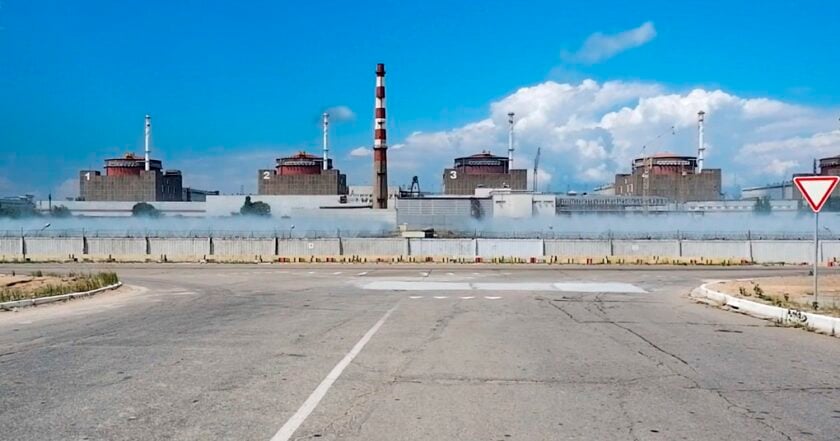Environmental disaster or radiation accident at Zaporizhzhia nuclear power plant

Фото: АР
The Zaporizhzhia nuclear power plant and its satellite city of Enerhodar have been under russian occupation since March 4, 2022. Since then, the occupiers' senseless and terrorist actions have led to many critically dangerous situations, resulting in the power units of the ZNPP being put into a state of cold shutdown. In addition, massive shelling leads to permanent disconnections from Ukraine's unified energy system, due to which the internal needs of nuclear power plants are forced to be compensated by diesel generators.
Ukraine and the world are constantly teetering on the brink of a nuclear disaster, but this turned out to be not enough. As a result of the shutdown of the power units, warm water does not enter the cooling pond of the ZNPP, so the temperature of the reservoir has dropped to +13 degrees, and it has become too cold for the species that live there. There were reports of an ecological disaster — a large-scale plague of fish. However, despite the seriousness of the situation, it is worth considering and discussing the risks associated with this stage of the station's occupation.
Cooling ponds are used to cool the heated circulating water from the NPP's circulating water supply systems. Cooling is carried out as a result of evaporation and convective heat transfer. Such reservoirs are usually shallow — up to 3.5-4 meters — large in area and separated from other water bodies.
Since the cooling reservoirs are separated, they form a special ecosystem in which it is necessary to create mechanisms to combat bloom, overgrowth, and mineralization. To do this, they are stocked with thermophilic species that are not inherent in the water ecosystems of Ukraine. In particular, the pond near the ZNPP was stocked with warm-water tilapia and Asian catfish, and at temperatures above +18°C, the fish could live and reproduce normally.
As a result of the actions of the russian occupiers, the nuclear power plant actually stopped. The need for cooling the reactors became much lower, which led to a decrease in the temperature in the cooling pond by 5-7°C. These are unfavorable conditions, so there is a risk of a mass fish plague. This can be countered only on the condition of partial or complete restoration of the operation of the ZNPP nuclear reactors. And recently, Energoatom announced the withdrawal of power units 5 and 6 to a minimally controlled power level to obtain steam, which is necessary for winter to ensure the safety of power units, personnel, the population, and the environment. But is it really safe?
In recent months, russia has been committing open acts of terrorism, both against Ukraine's energy system and against Ukrainian nuclear facilities. Previously, we wrote about why power unit shutdowns occur due to power supply problems and what this can lead to. Therefore, taking into account the periodic missile attacks on the ZNPP by the russian side, the launch of reactors 5 and 6, even at a minimally controlled power level, could potentially have catastrophic consequences since the safest state of the NPP under such a threat is a cold shutdown.
According to the State Agency for the Management of the Exclusion Zone estimates, the possible consequences of a fire or explosion at the Zaporizhzhia nuclear power plant will exceed the consequences of the 1986 accident at the Chornobyl nuclear power plant by ten times. The potential area of the exclusion zone in the event of a disaster will reach 30,000 square km, which is 10 times more than the Chornobyl zone. The area of the potentially contaminated territory is up to 2 million km², and the Zaporizhzhia region will become uninhabitable. The degree of contamination of other territories of Ukraine and Europe, russia, and Belarus will depend on the wind.
In contrast, the mass killing of fish is undeniably terrible but carries fewer risks for the radiation safety of the European continent. Although cooling requires water of a certain quality and purity, usually maintained by tilapia and catfish, other purification mechanisms exist. Water from the cooling pond always passes through a multi-stage chemical and mechanical cleaning system. That is, when the regular operation of the ZNPP becomes possible, the power units' cooling will occur under any conditions.
So, talking about the possible fish plague in the cooling reservoir and the need to start power units, one must also take into account the whole set of risks associated with the operation of nuclear power plants during wartime, especially during a war against russia. Mass death of any species is a catastrophe. Still, compared to the potential risks of a radiation accident, which would be ten times greater than all nuclear disasters known to humanity, it is a forced lesser evil. The war and the russian occupiers present us with terrible choices every day. Currently, the main task is to confront russian nuclear terrorism and prevent the worst.






















































